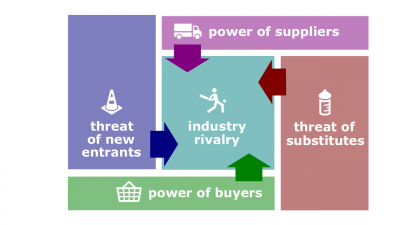Difference between revisions of "Porter's Five-Forces Model"
| Line 1: | Line 1: | ||
| − | [[File:Porter-forces.png|400px|thumb|right|[[Porter's five forces framework]]]][[Porter's Five-Forces Model]] (alternatively known as the [[Porter's five forces framework]]; hereinafter, the ''Framework'') is a tool that maps analyses of competition of a [[business]]. The five forces include (a) threat of new entrants, (b) threat of substitutes, (c) bargaining power of customers, (d) bargaining power of suppliers, and (e) industry rivalry. | + | [[File:Porter-forces.png|400px|thumb|right|[[Porter's five forces framework]]]][[Porter's Five-Forces Model]] (alternatively known as the [[Porter's five forces framework]]; hereinafter, the ''Framework'') is a tool that maps analyses of [[competition]] of a [[business]]. The five forces include (a) threat of new entrants, (b) threat of substitutes, (c) bargaining power of customers, (d) bargaining power of suppliers, and (e) industry rivalry. |
Latest revision as of 19:08, 6 May 2023
Porter's Five-Forces Model (alternatively known as the Porter's five forces framework; hereinafter, the Framework) is a tool that maps analyses of competition of a business. The five forces include (a) threat of new entrants, (b) threat of substitutes, (c) bargaining power of customers, (d) bargaining power of suppliers, and (e) industry rivalry.
Definitions
According to the Strategic Management by David and David (15th edition),
- Porter's Five-Forces Model. A theoretical model devised by Michael Porter, who suggests that the nature of competitiveness in a given industry can be viewed as a composite of five forces: 1) rivalry among competing firms, 2) Potential entry of new competitors, 3) Potential development of substitute products, 4) Bargaining power of suppliers, and 5) Bargaining power of consumers.
